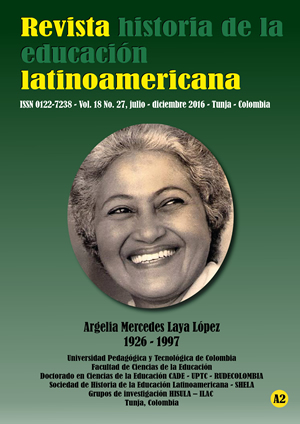Utawilaya rural school: A liberating Education in Puno - Peru 1902

Abstract
This paper details the development of the Indigenous and rural School Utawilaya in the district Chucuito Platera, in the province of Puno- Peru in 1902. Because of the educational, economic, social and political exclusion of the rural population by the State, the teacher Manuel Zuniga Camacho founded the Indigenous and rural School with a pedagogical stance towards a liberating education. Zúñiga Camacho considered education as the only way of salvation from exclusion, exploitation and poverty; established by the oligarchs and political bosses. Peruvian historiography agrees that one of the strongest movements in the southern highlands in the early twentieth century was the struggle for education, which was considered as a privilege for the upper class or ruling elite (oligarchy and tyranny). This research work is based on unpublished historical documents, which contribute to the study of the history of Puno. Library research methods and techniques have been applied for reviewing primary and secondary sources leading to analysis and criticism. The marginalization of indigenous peoples is not a current phenomenon; it comes from two hundred years ago within the framework of the republican history. This exclusion underlies the perception (still current) of indigenous people as backward and ignorant, who therefore are not included in the development policies of the Peruvian State. For (Aliaga, 2015) the incidence of poverty, ``on grounds of´´ mother tongue, affects mainly the population with a native language: Quechua or Aymara. Thus, in 2013, poverty affected 35.9 % of the population. The Utawilaya school literacy program included groups of adults and children. The liberating education of Manuel Zúñiga Camacho highlights the following transcendental aspects: people´s liberation, community transformation, awareness, change of reality into an environment without discrimination, exploitation, humiliation and entitled to education.
Keywords
Discrimination; education; teaching; school; exclusion; indigenous; rural
Supplementary File(s)
LA ESCUELA RURAL DE UTAWILAYA: UNA EDUCACIÓN LIBERADORA DESDE PUNO - PERÚ 1902 (Español)Author Biography
David Ruelas Vargas
Magíster en Didáctica de las Ciencias Sociales, Docente de la Facultad de Ciencias de la Educación, Especialidad de Ciencias Sociales de la Universidad Nacional del Altiplano Puno – Perú
References
- Bibliografía:
- Allpanchis. (1989). PODER Y AUTORIDAD EN LOS ANDES. SICUANI - CUSCO: INSTITUTO DE PASTORAL ANDINA.
- Alomia, M. (1998). Un Importante Centenario en la Historia de las Misiones. Con su Espíritu, 61.
- Basadre, J. (1963). Historia de la República del Perú (1822-1933) (Quinta ed., Vol. 10). Lima, Perú: Ediciones Historia.
- Cano, J. (23 de Enero de 1914). LA UNIÓN. Lo de la Plateria , pág. 2.
- CARE. (2011). FICHAS BOTANICAS DE ESPECIES AGROFORESTALES. PAZ: CARE y Programa Nacional de Cambio.
- Cabrera, I. I. R., & Gallardo, T. de J. L. (2013). EL ENFOQUE DE FORMACIÓN HUMANÍSTICO INTERCULTURAL INTERCULTURAL EDUCATION OF UNIVERSITY STUDENT : A HUMANISTIC- Isaac Iran Cabrera Ruiz Teresita de Jesús Gallardo López Isaac Iran Cabrera Ruiz 1.
- Ccahuana, J. A. (5 de Noviembre de 2013). Repositorio de tesis de la Pontificia Universidad Católica del Perú. Recuperado el 01 de Abril de 2016, de http://tesis.pucp.edu.pe/repositorio/bitstream/handle/123456789/5126/CCAHUANA_CORDOVA_JORGE_CAPACIDAD_INDIGENA.pdf?sequence=1
- Citarela, L., Amadio, M., & Zuñiga, M. (1990). LA EDUCACIÓN INDIGENA EN AMERICA LATINA (Vol. Tres). Quito, Ecuador: ABYA AYALA - UNESCO.
- Citarela, L., Amadio, M., & Zuñiga, M. (1990). LA EDUCACIÓN INDIGENA EN AMERICA LATINA (Vol. Tres). Quito, Ecuador: ABYA AYALA - UNESCO.
- Gallegos, L. (1974). El Campesino Rebelde del Altipampa. Puno, Perú: Centro de estudios y Reflexiones.
- Gallegos, L. (1993). Biografía de un Aymara. Puno: Universitaria.
- INEI. (2010). "Informe técnica: evolución de la pobreza al 2009". Lima: INEI.
- INEI. (01 de Mayo de 2014). INEI. Recuperado el 03 de Yayo de 2016, de https://www.inei.gob.pe/media/cifras_de_pobreza/informetecnico.pdf
- Kapsoli, W. (1977). Los Movimientos Campesinos en el Perú 1879-1965. Lima, Perú: Delva Editores.
- Knobel, M., & Lankshear, C. (2002). Tres Enfoques para la Investigación Educativa. México: UNAM.
- Lankshea, C., & Lankshear, C. (2002). Tres Enfoques para la Investigación. Mexico: UNAM.
- Málaga, X. (14 de Octubre de 2014). PONTIFICIA UNIVERSIDAD CATÓLICA DEL PERÚ. Obtenido de http://tesis.pucp.edu.pe/repositorio/bitstream/handle/123456789/5716/MALAGA_SABOGAL_XIMENA_EDUCACION_PUNO.pdf?sequence=1
- Mariátegui, J. (1979). 7 ENSAYOS DE INTERPRETACIÓN DE LA REALIDAD PERUANA. (Vol. I). Ayacucho, Perú: Fundación Biblioteca Ayacucho.
- MPP. (20014). Plan Estrategico Institucional. Obtenido de www.munipuno.gob.pe/descargas/.../plan_estrategico_institucional.pdf
- Núñez Núñez, H. (2008). UNMSM. Obtenido de Tesis: http://cybertesis.unmsm.edu.pe/bitstream/cybertesis/3113/1/Nu%C3%B1ez_nh.pdf
- Portugal, J. (30 de Octubre de 2012). Blog Portugal. Recuperado el 01 de Mayo de 2016, de http://joseportugalcatacora.blogspot.pe/2012/10/manuel-z-camacho.html
- Portugal, J. (2013). Historia de la Educación en Puno. Puno, Perú: Corporación MERU E.I.R.L.
- Rénique, J., & Deustua, J. (1984). Intelectuales, indigenismo y descentralismo en el Perú, 1897-1931. Cusco, Perú: Centro Bartolomé de las Casas.
- Tamayo, J. (1982). HISTORIA SOCIAL E INDIGENISMO EN EL ALTIPLANO. Lima, Perú: Trentaitrés.
- UNICEF. (2011). Estado de la Niñez en el Perú. Lima, Perú: Asociación Gráfica Educativa.
- Tito, J. (2013). EL PAPEL DEL ACTIVISMO INDIGENISTA Y DEL PROTESTANTISMO MISIONERO EN LAS LUCHAS SOCIALES EN EL ALTIPLANO (1920-1923), 1–17.
